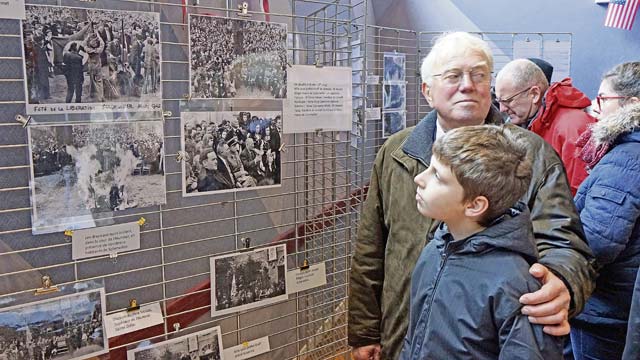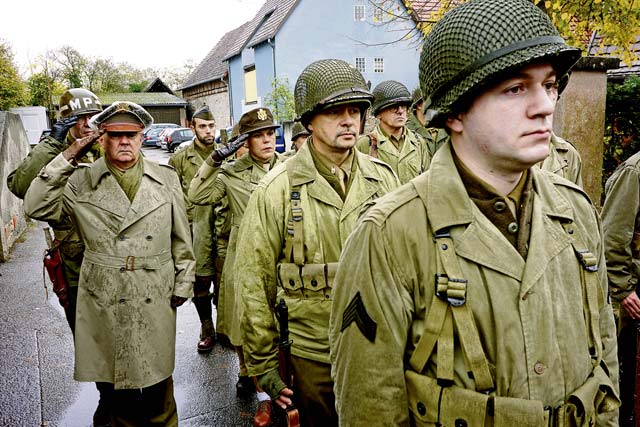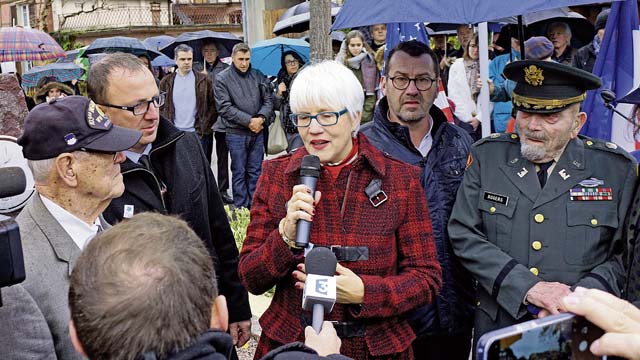



SCHERWILLER, France — On Nov. 11, the people of this Alsatian community near the German border honored American Army veterans of World War II who served with the 103rd Infantry Division. The unit liberated the town from the Nazis on Dec. 1, 1944.
The memorial contains a large metal plaque of the 103rd’s distinctive patch, mounted on a slender gray and brown pyramid of roughly hewn granite, placed next to the town’s center.
Representing the 103rd Infantry Division were retired Col. Cranston (Chan) Rogers, who served as a private in the 103rd ID and later served under the 45th Infantry in the liberation of the concentration camp at Dachau; and Mr. Calvin (Buck) Landau, who served as a sergeant in the 103rd ID throughout its campaigns in France and Germany.
Ronald Curry was also present to receive honors on behalf of his father, Alva Curry, who served as a second lieutenant in the division.
Additionally, several members of the honorees’ families also travelled to Germany and attended the dedication.
The three men, along with Helen Patton, granddaughter of Gen. George Patton, spent the day celebrating the town’s liberation.
They attended a French memorial dedicated to Scherwiller veterans and civilians lost and wounded during the war. Then, they moved with the crowd of about 200 onlookers across the town square for the dedication of a memorial to the 103rd.
The 103rd is known as the “Cactus Division,” a moniker taken from the Saguaro shown on the unit’s shoulder patch, and its origins in the Southwest U.S. in the years after World War I. The Army Reserve’s modern-day 103rd Expeditionary Sustainment Command, based in Des Moines, Iowa, traces its lineage back to the 103rd Infantry Division.
In brief statements during the ceremony, Rogers stressed the importance of remembering the sacrifice both countries made during the war and the need for a continued alliance against ongoing threats to freedom and the prevention of a third world war.
Landau reflected on the honor of his service in the 103rd. Despite more than 70 years that have passed since the war, he choked back tears as he added that he’d never forget his friends from the 103rd who did not make the trip home.
And though the better part of four generations have passed, the memories of the war seem to remain in the Scherwiller collective mind.
Captains Daniel Jost and Andrew Pollick of the Army Reserve’s 7th Mission Support Command were escorts for the honored veterans. They attended both the ceremony and the dining event that followed.
Among those attending the dinner was a local WWII re-enactment group called the U.S. Army Group of Alsace, whose members dressed in period uniforms to participate in the ceremony.
Jost has roots in Alsace-Lorraine and resides there part-time.
“Speaking with some of the younger participants, I got the sense that there is a lot of interest and passion to go along with the high degree of respect for what an entire generation of Americans did for the French during WWII,” Jost said.
The front line units of the 103rd saw heavy resistance throughout the campaigns of Ardennes-Alsace, Rhineland, and Central Europe. After its relief of the 3rd Division at Chevry, France, in October 1944, the units of the 103rd pushed eastward at a rapid pace before eventually liberating Scherwiller on Dec. 1, and then neighboring Selestat on Dec. 4, 1944. After that, they continued into the Rhineland area of Germany.
The 103rd Infantry Division World War II Association, of which Rogers is President, is located on the University of Southern Mississippi campus, in Hattiesburg, Miss.


